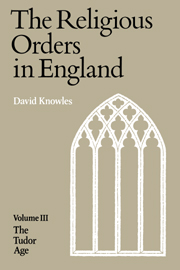Book contents
- Frontmatter
- Contents
- Preface
- List of Abbreviations
- Part One The Tudor Scene
- Part Two The Gathering Storm
- Part Three Suppression and Dissolution
- Part Four Reaction and Survival
- Appendix I Sir Thomas More's letter ‘to a monk’
- Appendix II Religious houses suppressed by Cardinal Wolsey
- Appendix III The witness of the Carthusians
- Appendix IV Houses with incomes exceeding £1000 in the Valor Ecclesiasticus
- Appendix V The sacrist of Beauvale
- Appendix VI Itinerary of the visitors, 1535–6
- Appendix VII The commissioners for the survey of the Lesser Houses in 1536
- Appendix VIII The conflict of evidence on the monasteries
- Appendix IX The last abbots of Colchester, Reading and Glastonbury
- Appendix X Regulars as bishops
- Bibliography
- Index
Appendix I - Sir Thomas More's letter ‘to a monk’
Published online by Cambridge University Press: 08 January 2010
- Frontmatter
- Contents
- Preface
- List of Abbreviations
- Part One The Tudor Scene
- Part Two The Gathering Storm
- Part Three Suppression and Dissolution
- Part Four Reaction and Survival
- Appendix I Sir Thomas More's letter ‘to a monk’
- Appendix II Religious houses suppressed by Cardinal Wolsey
- Appendix III The witness of the Carthusians
- Appendix IV Houses with incomes exceeding £1000 in the Valor Ecclesiasticus
- Appendix V The sacrist of Beauvale
- Appendix VI Itinerary of the visitors, 1535–6
- Appendix VII The commissioners for the survey of the Lesser Houses in 1536
- Appendix VIII The conflict of evidence on the monasteries
- Appendix IX The last abbots of Colchester, Reading and Glastonbury
- Appendix X Regulars as bishops
- Bibliography
- Index
Summary
More's letter ‘to a monk’ was published in Epistolae aliquot eruditorum (1520), and thence by Miss E. F. Rogers, Correspondence of Sir Thomas More, no. 83, pp. 165–206. More does not name his correspondent, nor is there any direct clue to his identity in the letter itself. Strangely enough, neither the latest editor nor, so far as I am aware, any previous writer, has made any attempt at identification. All that the letter tells us is that More had known his correspondent ‘in the world’; that he was an autodidact; that he was a monk of a ‘contemplative’ Order and a priest; and that he was still young (cf. Rogers, pp. 167, 190, 193: ‘Tu juvenis αὐτοδίδακτος’). We know from other sources of one and only one English monk who attacked Erasmus's New Testament, the Carthusian John Batmanson of London, who died in office as prior in 1531. This Batmanson has been identified, tentatively in DNB and with more assurance by later writers, with John Batmanson, D.C.L., who appears in the records of the time as a figure of some importance in public life, from which he disappears c. 1516. That Erasmus should have referred to his opponent slightingly as a young man has been taken by P. S. Allen and others as an instance of the humanist's wilful discourtesy towards his critics. To the present writer it had long seemed that Batmanson must be More's correspondent, but the identification of the prior with the aged lawyer appeared to be an insuperable difficulty.
- Type
- Chapter
- Information
- The Religious Orders in England , pp. 469 - 470Publisher: Cambridge University PressPrint publication year: 1979



